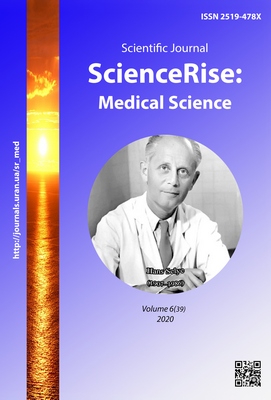Стан ендотелію та роль імунокомпетентних клітин у розвитку атеросклерозу як причини ішемічного інсульту
DOI:
https://doi.org/10.15587/2519-4798.2020.220202Ключові слова:
атеросклероз, ендотелій, імунокомпетентні клітини, макрофаги, лімфоцити, ішемічний інсульт, CD4, CD8, CD20, CD68, CD31Анотація
Мета. Визначити стан ендотелію судин головного мозку та роль імунокомпетентних клітин у розвитку ішемічного інсульту на фоні атеросклерозу.
Матеріали і методи. Досліджені судини головного мозку 50 померлих з ішемічними інфарктами головного мозку, 50 – з вираженим атеросклерозом судин головного мозку без проявів ЦВЗ та 50 померлих від причин не пов'язаних із ЦВЗ та атеросклерозом (група порівняння). Гістологічні препарати судин фарбували гематоксиліном-еозином, трихромом за Масоном, а також проводили імуногістохімічне дослідження з використанням маркерів CD31/PECAM-1(Endothelial Cell Marker)Ab-1, CD4 (CD4 Ab-8), CD8 (SP 16), CD20 (CD20 Ab-1) CD68 та (CD68/Makrophager Marker Ab-4).
Результати. Ендотелій судин головного мозку при ішемічних інсультах та вираженому атеросклерозі набуває структурних змін у вигляді розриву, десквамації і відшарування, утворення скупчень десквамованих ендотеліоцитів. Говорячи про пошкодження ендотелію, не слід думати, що зміни повинні відбуватись на макроскопічному рівні, достатньо ураження ендотелію на клітинному рівні. В розвитку атеросклерозу значне місце посідають імунокомпетентні клітини, адгезія моноцитів на лумінальній поверхні артерій, наявність великої кількості цих клітин під ендотелієм, а більш зрілих макрофагів у глибині інтими, свідчить про поступлення цих клітин з крові в стінку артерії, які активно потенціюють утворення атеросклеротичної бляшки.
Висновки. Порушення ендотеліального покриву із зміною морфології ендотеліальних клітин, сприяють розвитку атеросклеротичних бляшок. Лімфоцити і макрофаги складають молекулярну основу багатьох важливих процесів, включаючи запальну реакцію і імунну відповідь
Посилання
- Zinchenko, O. M., Mishchenko, T. S. (2016). Stan nevrolohichnoi sluzhby v Ukraini v 2015 rotsi. Kharkiv, 23.
- Zozulia, I. S., Zozulia, A. I. (2011). Epidemiolohiia tserebrovaskuliarnykh zakhvoriuvan v Ukraini. Ukrainskyi medychnyi chasopys, 5, 38–41.
- Mishchenko, T. S. (2010). Analiz epidemiolohii tserebrovaskuliarnykh khvorob v Ukraini. Sudynni zakhvoriuvannia holovnoho mozku, 3, 2–11.
- Mischenko, T. S. (2017). Epidemiologiia tserebrovaskuliarnykh zabolevanii i organizatsiia pomoschi bolnym s mozgovym insultom v Ukraine. Ukrainskii vіsnik psikhonevrologіi, 25 (90), 22–24.
- Moshenska, O. P. (2011). Fatalnyi ishemichnyi insult: osoblyvosti naihostrishoho periodu. Ukrainskyi medychnyi chasopys, 1 (81), 29–35.
- Fartushna, O. Ye., Vinychuk, S. M. (2015). Vyiavlennia ta usunennia vaskuliarnykh chynnykiv ryzyku – vazhlyvyi napriamok pervynnoi profilaktyky tranzytornykh ishemichnykh atak ta/chy insultu. Ukrainskyi medychnyi chasopys, 1, (105), 23–27.
- Bobryshev, Iu. V., Karagodin, V. N., Kovalevskaia, Zh. I. et. al. (2010). Kletochnye mekhanizmy ateroskleroza: vrozhdennii immunitet i vospalenie. Fundamentalnye nauki i praktika, 1 (4), 140–148.
- Shimada, K. (2009). Immune system and atherosclerotic disease. Heterogeneity of Leukocyte Subsets Participating in the Pathogenesis of Atherosclerosis. Circulation Journal, 73 (6), 994–1001. doi: http://doi.org/10.1253/circj.cj-09-0277
- Gotsman, I., Gupta, R., Lichtman, A. H. (2007). The Influence of the Regulatory T Lymphocytes on Atherosclerosis. Arteriosclerosis, Thrombosis, and Vascular Biology, 27 (12), 2493–2495. doi: http://doi.org/10.1161/atvbaha.107.153064
- Schafer, A., Bauersachs, J. (2008). Endothelial Dysfunction, Impaired Endogenous Platelet Inhibition and Platelet Activation in Diabetes and Atherosclerosis. Current Vascular Pharmacology, 6 (1), 52–60. doi: http://doi.org/10.2174/157016108783331295
- George, A. L., Bangalore-Prakash, P., Rajoria, S., Suriano, R., Shanmugam, A., Mittelman, A., Tiwari, R. K. (2011). Endothelial progenitor cell biology in disease and tissue regeneration. Journal of Hematology & Oncology, 4 (1), 24. doi: http://doi.org/10.1186/1756-8722-4-24
- Münzel, T., Sinning, C., Post, F., Warnholtz, A., Schulz, E. (2008). Pathophysiology, diagnosis and prognostic implications of endothelial dysfunction. Annals of Medicine, 40 (3), 180–196. doi: http://doi.org/10.1080/07853890701854702
- Ammirati, E., Moroni, F., Magnoni, M., Camici, P. G. (2015). The role of T and B cells in human atherosclerosis and atherothrombosis. Clinical & Experimental Immunology, 179 (2), 173–187. doi: http://doi.org/10.1111/cei.12477
- Jones Buie, J. N., Oates, J. C. (2014). Role of Interferon Alpha in Endothelial Dysfunction: Insights Into Endothelial Nitric Oxide Synthase–Related Mechanisms. The American Journal of the Medical Sciences, 348 (2), 168–175. doi: http://doi.org/10.1097/maj.0000000000000284
- Vanhoutte, P. M. (2009). Endothelial Dysfunction. Circulation Journal, 73 (4), 595–601. doi: http://doi.org/10.1253/circj.cj-08-1169
- Regina, C., Panatta, E., Candi, E., Melino, G., Amelio, I., Balistreri, C. R. et. al. (2016). Vascular ageing and endothelial cell senescence: Molecular mechanisms of physiology and diseases. Mechanisms of Ageing and Development, 159, 14–21. doi: http://doi.org/10.1016/j.mad.2016.05.003
##submission.downloads##
Опубліковано
Як цитувати
Номер
Розділ
Ліцензія
Авторське право (c) 2020 Nataliia Chuiko

Ця робота ліцензується відповідно до Creative Commons Attribution 4.0 International License.
Наше видання використовує положення про авторські права Creative Commons CC BY для журналів відкритого доступу.
Автори, які публікуються у цьому журналі, погоджуються з наступними умовами:
1. Автори залишають за собою право на авторство своєї роботи та передають журналу право першої публікації цієї роботи на умовах ліцензії Creative Commons CC BY, котра дозволяє іншим особам вільно розповсюджувати опубліковану роботу з обов'язковим посиланням на авторів оригінальної роботи та першу публікацію роботи у цьому журналі.
2. Автори мають право укладати самостійні додаткові угоди щодо неексклюзивного розповсюдження роботи у тому вигляді, в якому вона була опублікована цим журналом (наприклад, розміщувати роботу в електронному сховищі установи або публікувати у складі монографії), за умови збереження посилання на першу публікацію роботи у цьому журналі.










